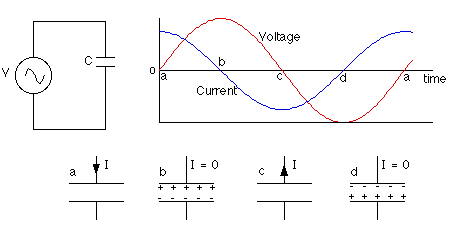
Related Terms
Alternating current
Direct current (DC) circuits involve current flowing in one direction. In alternating current (AC) circuits, instead of a constant voltage supplied by a battery, the voltage oscillates in a sine wave pattern, varying with time as:
In a household circuit, the frequency is 60 Hz. The angular frequency is related to the frequency, f, by:
Vo represents the maximum voltage, which in a household circuit in North America is about 170 volts. We talk of a household voltage of 120 volts, though; this number is a kind of average value of the voltage. The particular averaging method used is something called root mean square (square the voltage to make everything positive, find the average, take the square root), or rms. Voltages and currents for AC circuits are generally expressed as rms values. For a sine wave, the relationship between the peak and the rms average is:
rms value = 0.707 peak value
Resistance in an AC circuit
Capacitance in an AC circuit

The relationship V = IR applies for resistors in an AC circuit, so
In AC circuits we'll talk a lot about the phase of the current relative to the voltage. In a circuit which only involves resistors, the current and voltage are in phase with each other, which means that the peak voltage is reached at the same instant as peak current. In circuits which have capacitors and inductors (coils) the phase relationships will be quite different.

Consider now a circuit which has only a capacitor and an AC power source (such as a wall outlet). A capacitor is a device for storing charging. It turns out that there is a 90° phase difference between the current and voltage, with the current reaching its peak 90° (1/4 cycle) before the voltage reaches its peak. Put another way, the current leads the voltage by 90° in a purely capacitive circuit.
To understand why this is, we should review some of the relevant equations, including:
relationship between voltage and charge for a capacitor: CV = Q
Inductance in an AC circuit

An inductor is simply a coil of wire (often wrapped around a piece of ferromagnet). If we now look at a circuit composed only of an inductor and an AC power source, we will again find that there is a 90° phase difference between the voltage and the current in the inductor. This time, however, the current lags the voltage by 90°, so it reaches its peak 1/4 cycle after the voltage peaks.
The reason for this has to do with the law of induction:
Applying Kirchoff's loop rule to the circuit above gives:
As the voltage from the power source increases from zero, the voltage on the inductor matches it. With the capacitor, the voltage came from the charge stored on the capacitor plates (or, equivalently, from the electric field between the plates). With the inductor, the voltage comes from changing the flux through the coil, or, equivalently, changing the current through the coil, which changes the magnetic field in the coil.
To produce a large positive voltage, a large increase in current is required. When the voltage passes through zero, the current should stop changing just for an instant. When the voltage is large and negative, the current should be decreasing quickly. These conditions can all be satisfied by having the current vary like a negative cosine wave, when the voltage follows a sine wave.
How does the current through the inductor depend on the frequency and the inductance? If the frequency is raised, there is less time to change the voltage. If the time interval is reduced, the change in current is also reduced, so the current is lower. The current is also reduced if the inductance is increased.
As with the capacitor, this is usually put in terms of the effective resistance of the inductor. This effective resistance is known as the inductive reactance. This is given by:
where L is the inductance of the coil (this depends on the geometry of the coil and whether its got a ferromagnetic core). The unit of inductance is the henry.